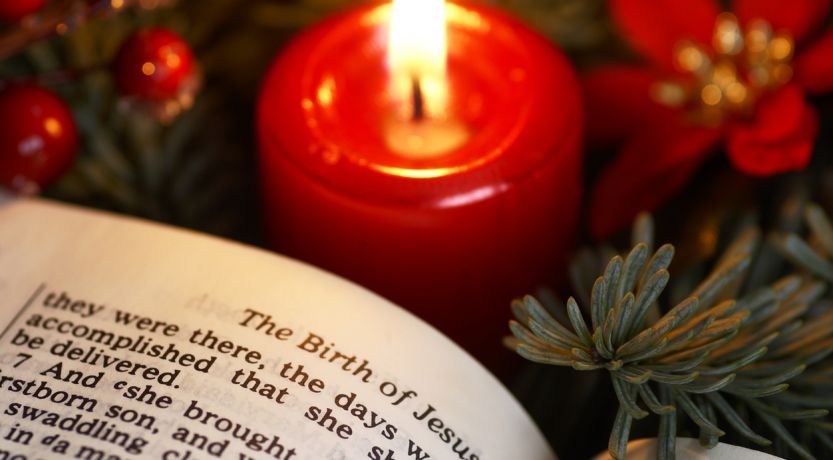What Is Religious Syncretism? Does God Accept It?
Many of Christianity’s popular traditions come from syncretism. What is religious syncretism? What are some modern examples of it? Does it matter to God?

Mixing the story of Jesus’ birth with ancient celebrations of the birth of the sun god is a prime example of religious syncretism.
What is syncretism?
Syncretism is the blending of different religious beliefs, ideas or practices together to form a new religious belief system or practice.
They’ll sing songs, exchange gifts, decorate their homes with lights and maybe visit family. Some will even attend church. Many, but not all, will do this to celebrate the birth of Jesus.
But here’s a bold statement: None of it will please God.
These so-called “Christian” traditions, and many others that are commonplace today, originally had nothing at all to do with Christianity. In reality, they were grafted into the religion through a process called syncretism.
Syncretism played a substantial role in shaping what is commonly considered to be Christianity—and it should be a matter of concern for anyone claiming to follow God.
Before you celebrate another Christmas, you need to understand syncretism—what it is, what God says about it and the danger it poses.
What is the definition of religious syncretism?
According to the Encyclopaedia Britannica, religious syncretism is “the fusion of diverse religious beliefs and practices.”
Though not exclusive to Christianity, the term commonly refers to the integration of non-Christian (pagan) practices into Christian beliefs, concepts and practices. Gradually, traditional Christianity incorporated diverse traditions, beliefs and holidays with roots tracing back to pagan religions.
Today, many self-identifying Christians may be surprised to learn how many of their cherished traditions and practices were assimilated into Christianity through syncretism with paganism.
Examples of syncretism in modern Christian religion
In the ancient world, different groups often adopted each other’s gods and practices in order to gain followers and allies.
The Roman Empire was especially adept at this, offering a religious freedom almost unheard of at the time. As the empire expanded and encompassed diverse cultures, it accepted practically every god of every conquered people into the Roman pantheon.
Many would assume Rome’s syncretistic practices ended in the fourth century when, under the reign of Constantine the Great, the empire adopted Christianity. However, this is not what happened. Instead, the form of mainstream Christianity that developed from Rome grew primarily by embracing syncretism.
In its early years, the Roman Church made adopting elements from other religions a common practice to win followers out of paganism.
In its early years, the Roman Church made adopting elements from other religions a common practice to win followers out of paganism. They believed that accommodating others’ beliefs would strengthen the church and cause it to grow in numbers.
History shows that syncretism was enormously influential in growing the church’s followers. In the book Christianity and Paganism in the Fourth to Eighth Centuries, historian Ramsay MacMullen writes, “The triumph of the church was one not of obliteration [of non-Christian beliefs] but of widening embrace and assimilation” (1997, p. 159).
These changes weren’t temporary either. Many of the syncretistic compromises that the Roman Catholic Church made in the fourth through eighth centuries are still common in today’s Christianity.
Most modern Christian holidays can easily be traced back to ancient pagan festivals.
For example, it is common knowledge that Christmas replaced the Roman Saturnalia, which took place in late December on the Roman calendar.
According to an article on History.com: “It is commonly believed that the church chose this date in an effort to adopt and absorb the traditions of the pagan Saturnalia festival” (“History of Christmas”).
Additionally, Catholicism endorsed the use of images and statues for prayer. These depictions, while supposedly featuring Christ, God the Father, the cross, Mary and the apostles, actually bear resemblances to the characteristics of Greco-Roman gods from ancient times. Facing a lack of biblical descriptions for these personalities, Catholic artists drew inspiration from the portrayals of past gods.
To learn about this and other examples of pagan practices that were syncretized into Christianity, read:
- “Where Did the Popular Image of Jesus Come From?”
- “Is Christmas a Pagan Holiday?”
- “Who Changed the Day of Worship From Saturday to Sunday? Why?”
- “The Surprising History of Easter”
- “Mardi Gras: Should It Be on the Christian Calendar?”
- “The Roots and Fruits of New Year’s Eve”
- “Valentine’s Day Is Pagan? So What?”
Modern Christianity is infused with numerous pagan-derived practices. Yet does it really matter that the religion incorporates syncretized elements from paganism?
Does God accept religious syncretism?
The Bible provides clear instructions on how to worship God, specifying how He does—and does not—want to be worshipped.
Consider: If God tells us precisely how to worship and honor Him, what gives human beings the right to make changes based on what we want to do?
In Deuteronomy 12:29-31, as the Israelites were about to possess the Promised Land, God strongly warned them not to follow the worship practices of the surrounding nations. He commanded them not to become enamored with how other peoples worshipped their gods.
In verse 31, He said: “You shall not worship the LORD your God in that way; for every abomination to the LORD which He hates they have done to their gods; for they burn even their sons and daughters in the fire to their gods.”
The people of Israel didn’t listen to this warning and were eventually punished with captivity because they brought pagan rituals into their worship. Instead of being a role model to the nations of fidelity to God through undefiled worship, they syncretized many elements of pagan worship—especially from the religions of Egypt, Canaan and Babylon—into their worship.
No matter how well-intentioned our worship may be, good intentions cannot transform something that’s pagan into something that’s righteous.
While the extreme example of child sacrifice is mentioned in Deuteronomy 12, this abomination wasn’t the only pagan practice that God wanted His people to avoid in their worship. After all, they committed “every abomination,” including many spiritual sins that God always condemns.
The God who condemns child sacrifice also denounces idolatry and pagan festivals as wrong. It isn’t for us to pick and choose which pagan practices can be “Christianized.” In fact, nothing pagan is ever “Christianized” because a true Christian should avoid pagan worship altogether.
But some may object to this.
In mainstream Christianity, some believe that if a pagan practice is repurposed to “praise” God, it ceases to be pagan. After all, the reasoning goes, does God really care how we worship Him, as long as it’s done in love?
But consider this analogy: if a relative had a dog allergy, you wouldn’t give him or her a German shepherd. Similarly, if a friend had a crippling fear of heights, you wouldn’t take him bungee jumping to celebrate your friendship. We go to great lengths to accommodate the preferences of human beings, yet many are unwilling to make even a little effort to align their practices with God’s preferences.
No matter how well-intentioned our worship may be, good intentions cannot transform something that’s pagan into something that’s righteous. Christians are called not only to worship God with love; they are also directed to worship Him in truth (John 4:23-24). In other words, their worship is to be in alignment with His revealed will.
And God has not changed (Malachi 3:6). If God disapproved of pagan rituals thousands of years ago, He continues to detest the sanitized, “Christianized” versions of those same rituals today.
For more insight on the issue of merging paganism with the teachings of the Bible, read “Does It Matter That Christmas Is Pagan?” and “Four Reasons Christmas Is Not a Christian Holiday.”
Worship God as He commands
In modern times, it can be easy to casually adopt the traditions of mainstream Christianity without truly reflecting on their origins.
Traditions can be good (2 Thessalonians 2:15), but only if they fall within the boundaries of God’s law. Pagan traditions, no matter how sincere, fall outside those boundaries.
Many “Christian” traditions (such as Christmas, Easter and Sunday services) and symbols are simply repackaged paganism. While people may believe these practices are now “Christian,” God, the all-knowing Creator, remembers their true origins.
True Christians align their beliefs and worship with God’s revealed will and obey His commandments (John 14:15, 23-24), rather than trying to impose their preferred mode of worship on God.
God’s inspired Word, the Bible, provides guidelines for worship and belief. If we invent or develop our own religious practices, are we truly worshipping Him—or something else?
We encourage our readers to sincerely examine their religious practices. Are your beliefs and worship based on religious syncretism? If so, we urge you to look seriously at God’s Word to learn how He wants to be worshipped.
Date Posted: December 25, 2024



